From fiery mountains to divine judgments, discover how volcanoes in the Bible offer a fascinating blend of myth and geology.

Volcano in the Bible
Surprisingly, over 70% of Earth's volcanoes are not even visible, lying beneath the ocean's surface, a fact that mirrors the hidden depths you'll find when exploring volcanoes in the Bible.
You've likely heard of Sodom and Gomorrah or the fiery summit of Mount Sinai, but have you considered these stories as more than just metaphors or divine interventions?
The Bible's descriptions of fire, smoke, and brimstone might hold keys to understanding how ancient peoples interpreted natural disasters.
To uncover how these biblical narratives and historical volcanic events intertwine, you'll need to look beyond the surface.
What revelations await in these ancient texts might challenge your perceptions of divine judgment and natural phenomena.
Key Takeaways
- Volcanic imagery in the Bible symbolizes divine presence, judgment, and intervention.
- Fire and smoke from volcanoes represent purification, divine wrath, and spiritual guidance.
- Biblical narratives link volcanic phenomena to moments of profound divine-human encounters.
- Prophetic visions use volcanic elements to signify cosmic divine judgment and the unveiling of the underworld.
Biblical Descriptions of Fire and Smoke
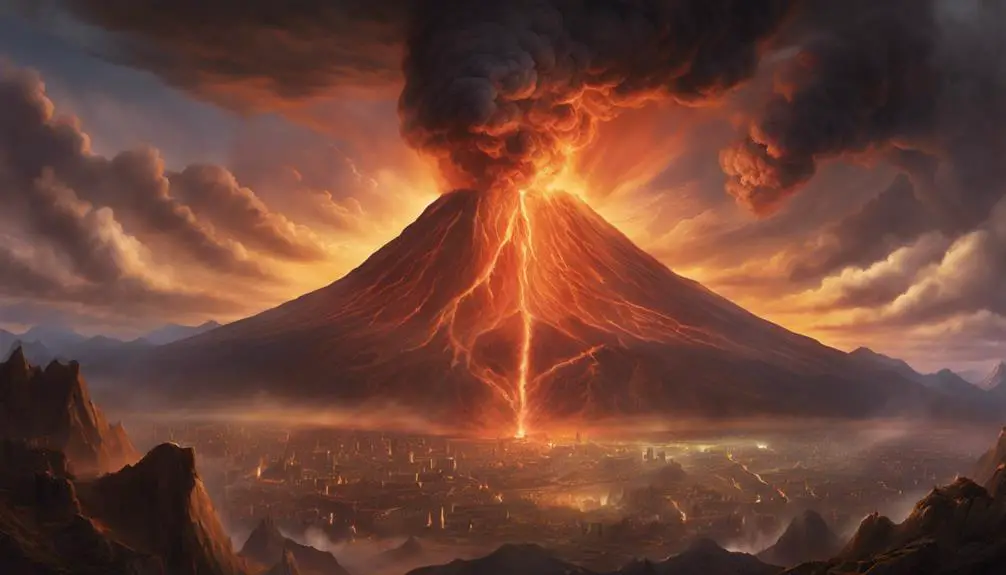
Throughout the Bible, vivid descriptions of fire and smoke often symbolize divine presence and wrath, inviting a deeper exploration of their theological and metaphorical significance. You'll find that fire symbolism isn't merely about destruction. It's multifaceted, signifying not just judgment but also purification, the Holy Spirit, and God's guidance. Similarly, smoke signals in these narratives aren't just remnants of fire but are emblematic of the mysteries of God, a visual manifestation of His glory and a physical barrier that both reveals and conceals the divine.
When you delve into the Pentateuch, particularly in Exodus, you're greeted with the burning bush incident, where fire represents God's call and commission to Moses, yet it doesn't consume the bush, suggesting a divine presence that enlightens but doesn't destroy. This intricate balance between destruction and guidance is a recurrent theme, illustrating the duality of fire symbolism in biblical texts.
Similarly, the smoke signals seen atop Mount Sinai during the giving of the Ten Commandments aren't just indicative of God's presence but also of His unapproachable holiness. This smoke, thick and enveloping, serves as a boundary that mortals can't cross, signifying the chasm between the divine and the human, yet it also communicates God's direct intervention in human affairs.
Analyzing these symbols, you recognize that they're not arbitrary but are deeply imbued with theological significance. They invite you to ponder the nature of God's interaction with humanity, His majesty, and the awe-inspiring respect He commands. Fire and smoke, therefore, aren't just elements of the physical world within the biblical narrative; they're key to understanding the divine character and the human-divine relationship.
The Story of Sodom and Gomorrah
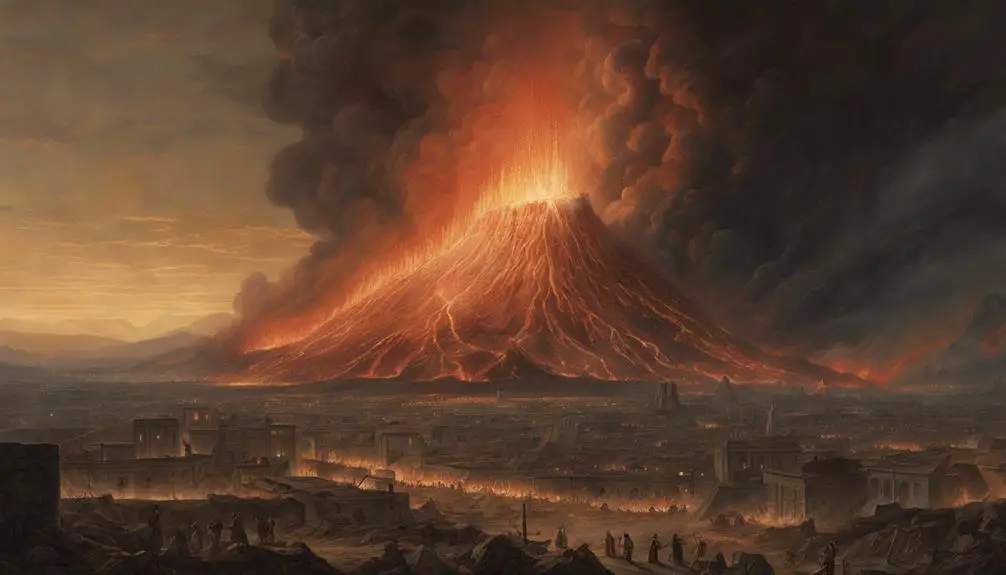
Delving into the narrative of Sodom and Gomorrah, we encounter a profound demonstration of divine judgment and mercy intertwined within the fabric of biblical history. This story, rich in its layers of moral and theological implications, offers a stark reflection on human behavior and divine response.
At the heart of this narrative is:
- Angelic warnings: Messengers from heaven forewarn of the impending doom, highlighting a divine grace that precedes judgment.
- Lot's escape: A pivotal moment where mercy and judgment intersect, underscoring the notion of divine protection for the righteous.
- Moral depravity: The cities of Sodom and Gomorrah symbolize the zenith of human wickedness, serving as a cautionary tale about the limits of divine patience.
- Divine intervention: The direct involvement of God in the affairs of humans, demonstrating both His power and His willingness to eradicate sin.
- A lesson in hospitality and righteousness: Through Lot and his family, we glean insights into the values esteemed by the divine, alongside the consequences of deviating from them.
Analyzing this story, one can't overlook the angelic warnings as a testament to God's mercy, allowing Lot and his family a chance to escape the impending destruction. This act of grace, however, is juxtaposed with the severe judgment meted out on the cities, illustrating a complex balance between mercy and justice. Lot's escape, specifically, serves as a beacon of hope and a reminder of the protection afforded to those who remain righteous amidst prevailing wickedness.
This narrative, deeply embedded in the tapestry of biblical lore, invites reflection on the themes of divine judgment, mercy, and the human capacity for both righteousness and depravity, offering timeless lessons for contemporary readers.
Mount Sinai's Fiery Summit
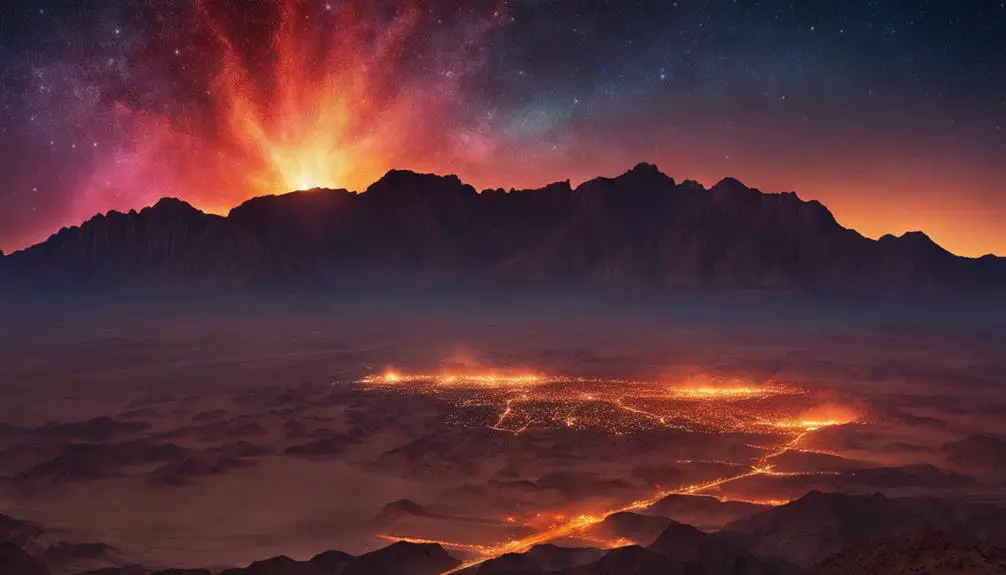
Reflecting on the narrative of Sodom and Gomorrah enriches our understanding as we now turn our attention to another significant biblical event: the fiery summit of Mount Sinai. This moment, emblematic of divine revelation, is laden with both geological evidence and cultural interpretations that deepen our comprehension of its significance.
Geologically, Mount Sinai's description as a fiery summit aligns with volcanic activity, which is a plausible explanation for the phenomena described in biblical texts. The vivid imagery of smoke, fire, and trembling ground suggests an encounter with a natural event of immense power, interpreted by those who witnessed it as a manifestation of the divine. Scholars have debated the exact location of Mount Sinai, but several candidates exhibit volcanic features, lending credence to this interpretation.
Culturally, this event has been embedded into the collective memory of multiple faith traditions, symbolizing a moment of profound encounter between the divine and the human. The fiery summit has been depicted in art, literature, and religious rituals, serving as a metaphor for spiritual awakening and the reception of divine law. These cultural interpretations enrich our understanding of the event, highlighting its enduring impact on human consciousness and society.
In analyzing the fiery summit of Mount Sinai, it's crucial to consider both the geological evidence and the cultural interpretations. Together, they offer a multifaceted view of this biblical event, underscoring its significance as a point of intersection between the natural world and the realm of the divine.
Prophetic Visions of Volcanic Imagery
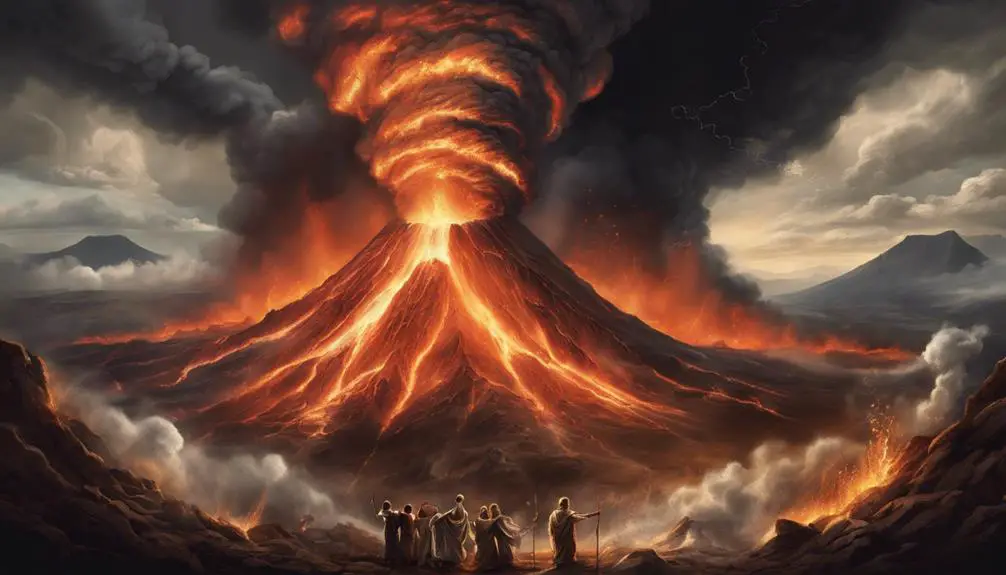
Turning our focus to prophetic visions, the Bible frequently employs volcanic imagery to symbolize divine intervention and judgment. This vivid usage of natural phenomena allows readers to grasp the magnitude of divine power and the serious consequences of human actions. Volcanic metaphors, brimming with apocalyptic symbolism, serve as a bridge between the spiritual realm and the tangible, chaotic events on Earth.
Understanding these metaphors requires delving into the textual layers and exploring the profound meanings beneath:
- Fire from the Sky: Often interpreted as divine wrath, this imagery conjures visions of a volcano erupting with such force that it seems as if the heavens themselves are ablaze.
- Mountains Shaking: Symbolizing the instability and transient nature of earthly powers in contrast to the eternal, unshakeable dominion of the divine.
- Opening of the Earth: Represents the unveiling of the underworld, a metaphor for divine judgment and the inevitable fate of those who stray from righteousness.
- Rivers of Fire: Imagery that evokes the destructive yet purifying nature of divine intervention, cleansing the world of iniquity.
- Darkened Sun and Bloodied Moon: Apocalyptic symbols that highlight the cosmic scale of divine judgment, affecting the very order of the universe.
These elements, threaded through prophetic visions, aren't just ancient rhetoric but are meant to stir the soul, urging contemplation and reverence. They encapsulate the awe-inspiring power of the divine, serving as a reminder of the fragile boundary between order and chaos, urging humanity towards moral rectitude in the shadow of potential divine judgment.
Historical Volcanic Events and the Bible
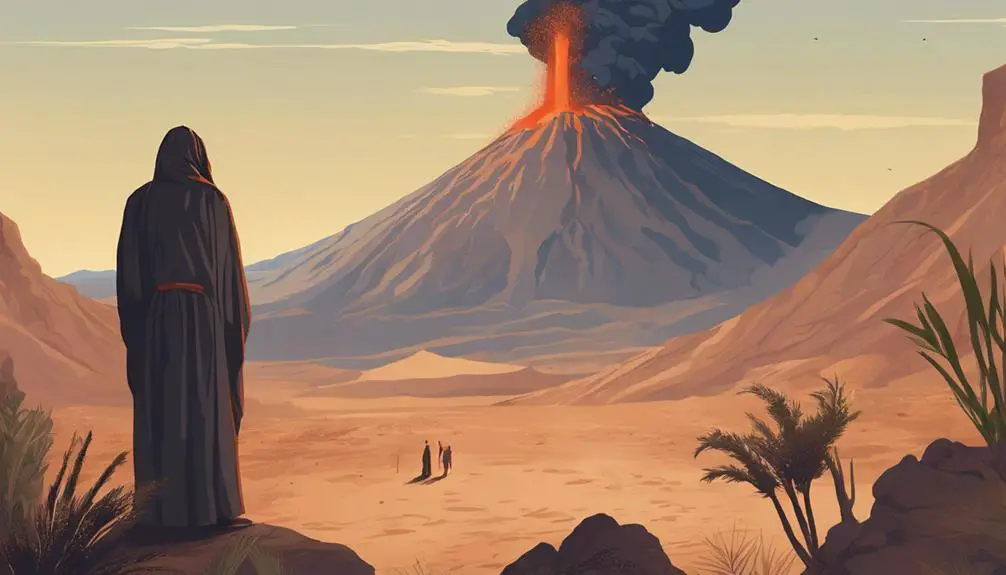
While the Bible employs volcanic imagery to illustrate divine power, it's also worth examining how actual historical volcanic events have influenced biblical narratives and interpretations. You mightn't initially see a direct Pompeii comparison within the scriptures, but a deeper dive into geologic evidence and historical context reveals fascinating parallels and insights.
Historical volcanic events, with their devastating power and transformative impact on landscapes and societies, offer a tangible context for understanding the biblical descriptions of divine interventions through natural phenomena. The destruction of cities, such as Pompeii, provides a real-world comparison to the biblical accounts of Sodom and Gomorrah, for instance. Though not explicitly described as a volcanic event in the Bible, the parallels in sudden destruction and the preservation of ruins have led scholars to explore geologic evidence that could link such narratives to actual volcanic activity.
Furthermore, the analysis of ancient ash layers and sediment deposits around the Near East strengthens the argument that volcanic activity could have been more prevalent during biblical times than previously thought. This geologic evidence suggests that the biblical authors might've been familiar with the effects of volcanic eruptions, indirectly influencing their use of such imagery to convey messages of power, judgment, and divine intervention.
Divine Judgment and Natural Disasters
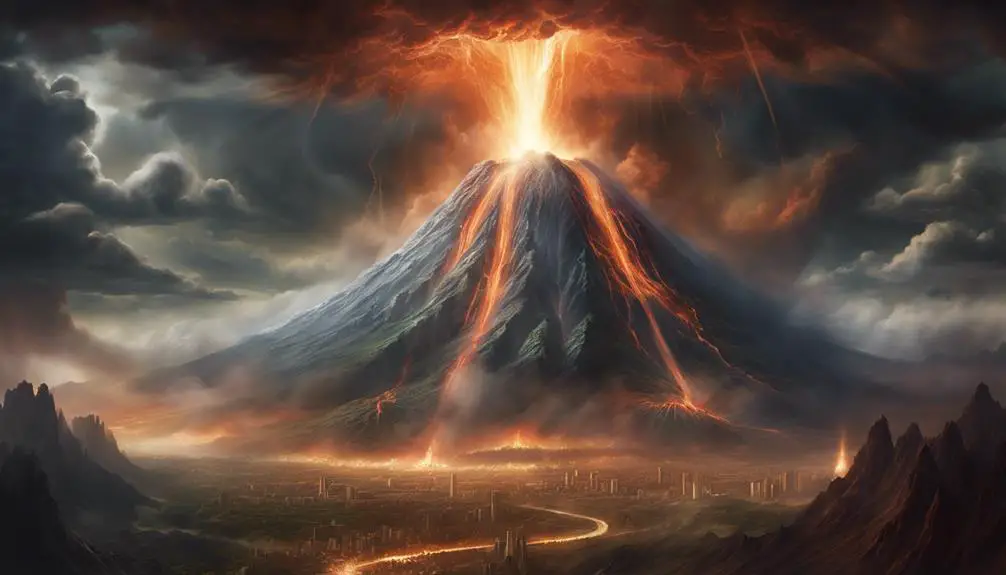
Throughout history, societies have often interpreted natural disasters, including volcanic eruptions, as manifestations of divine judgment. This perspective intertwines moral interpretations with the ecological consequences of such calamities, suggesting that human actions may influence divine will, leading to these catastrophic events.
- *Moral interpretations*: Many ancient texts, including biblical narratives, present natural disasters as a direct consequence of human sinfulness or moral failings. This viewpoint suggests a cosmic moral order that reacts to human behavior, often through dramatic ecological feedback.
- *Ecological consequences*: Beyond their immediate physical devastation, volcanic eruptions and similar disasters have long-term impacts on the environment, affecting climate, agriculture, and human settlements. These consequences are sometimes seen as prolonged reminders of divine displeasure.
- *Historical context*: The interpretation of natural disasters as divine judgment is deeply embedded in historical contexts, reflecting the understanding of nature and divinity prevalent in a society at any given time.
- *Psychological impact*: The fear and awe inspired by volcanic eruptions and other natural disasters can reinforce societal norms and values, as communities seek to appease perceived divine anger through moral rectitude.
- *Contemporary relevance*: While modern science provides explanations for natural disasters that don't rely on divine intervention, the metaphorical use of these events as commentary on human morality persists in some cultural narratives.
Analyzing these intersections of divine judgment with natural disasters underscores the complex ways in which human societies have historically made sense of their vulnerabilities to the forces of nature. This understanding not only shapes how events are remembered and interpreted but also influences ongoing discussions about morality, ecology, and the possibility of divine intervention in the natural world.
Frequently Asked Questions
How Do Modern Geological Findings Correlate With the Locations of Biblical Events That Suggest Volcanic Activity?
You're exploring how contemporary geological discoveries align with historical events indicating volcanic activity. Through volcanic dating techniques, scientists can pinpoint the timing of eruptions and assess their impacts on ancient civilizations.
This analysis reveals a fascinating correlation between recorded historical events and geological evidence of volcanic activity. It's a scholarly endeavor that interprets these findings, shedding light on the accuracy of historical accounts and the profound effect of volcanic eruptions on human history.
Are There Any Cultural or Spiritual Interpretations of Volcanoes in the Bible That Differ Significantly Between Ancient and Modern Perspectives?
You're exploring how cultural perceptions and spiritual symbolism of natural phenomena evolve. Ancient texts hint at awe and fear, interpreting volcanic eruptions as divine retribution or signs.
Modern perspectives often weave these events into broader narratives of ecological awareness and spiritual metaphor, contrasting sharply with earlier literal interpretations.
This shift reflects an evolving understanding of nature's power and our place within it, highlighting a deepened, though diverse, spiritual and cultural dialogue.
Has the Translation of Ancient Texts Ever Altered Our Understanding of Volcanic References in the Bible?
Absolutely, the translation of ancient texts, through the lens of textual criticism and linguistic evolution, can significantly shift your understanding of historical references, including those akin to volcanoes.
As languages evolve, so do interpretations of words and phrases. This evolution can alter perceptions of ancient texts, leading to a deeper, often different, understanding of historical events or phenomena.
It's a fascinating intersection of language, history, and culture that continues to shape our interpretations.
What Role Do Volcanoes Play in the Creation Narratives Found in the Bible, if Any?
In the tapestry of biblical narratives, you won't find volcanoes playing a starring role in creation stories. However, the undercurrent of geological symbolism woven through the text can't be ignored.
These natural phenomena mightn't erupt into the storyline explicitly, but as a creation metaphor, they remind you of the Earth's raw power and transformative capability.
Analyzing these references, you'll see they subtly underscore themes of renewal and divine intervention in the world's genesis.
How Have Descriptions of Volcanoes in the Bible Influenced Art, Literature, and Popular Culture Throughout History?
You've seen how volcanic symbolism and artistic metaphors have permeated culture, drawing from historical texts. These descriptions have captivated artists, writers, and filmmakers, transforming them into powerful images of destruction and creation.
Through centuries, this imagery has echoed in paintings, literature, and cinema, shaping our perception of awe and fear. This influence is a testament to the enduring power of natural phenomena to inspire human creativity and exploration across various mediums.
Conclusion
In your journey through the biblical landscape, you've witnessed how fire and smoke serve as powerful symbols, shaping narratives from Sodom and Gomorrah's destruction to the divine presence at Mount Sinai.
These stories, blending historical events with prophetic imagery, reflect a profound meditation on divine judgment and natural phenomena.
This interplay between the earthly and the divine, encapsulated in volcanic imagery, invites you to ponder the intricate relationship between human actions, divine will, and the natural world.

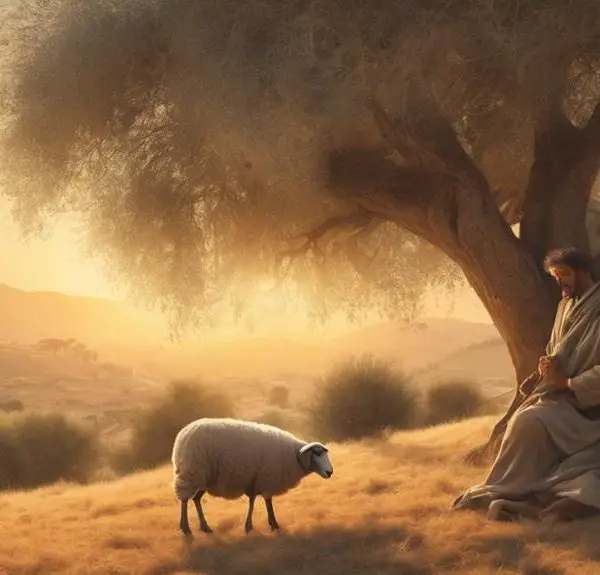

Sign up